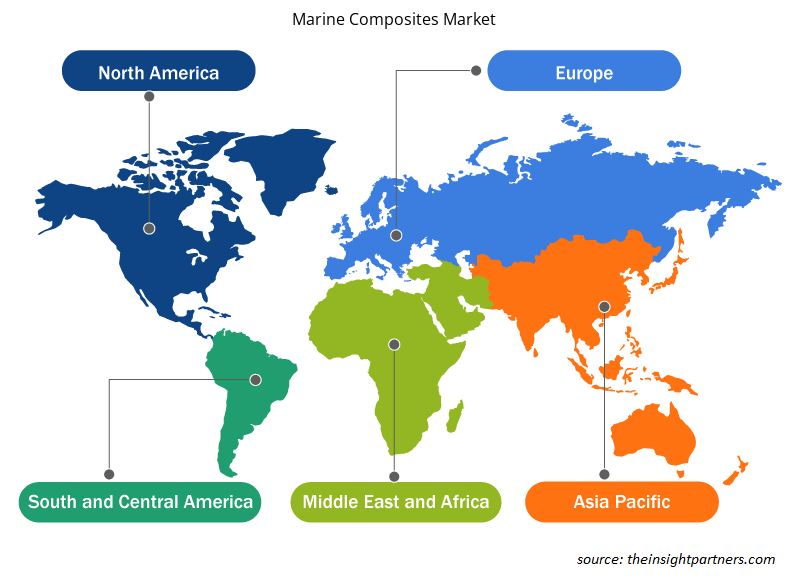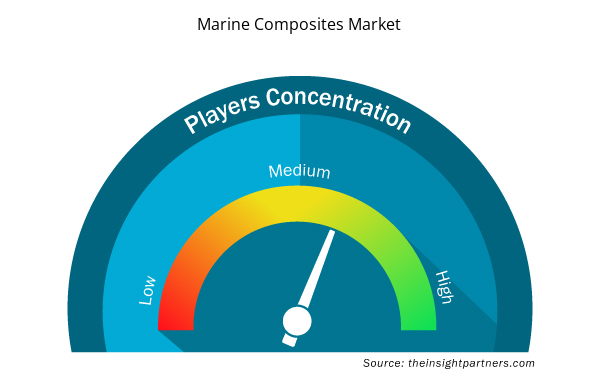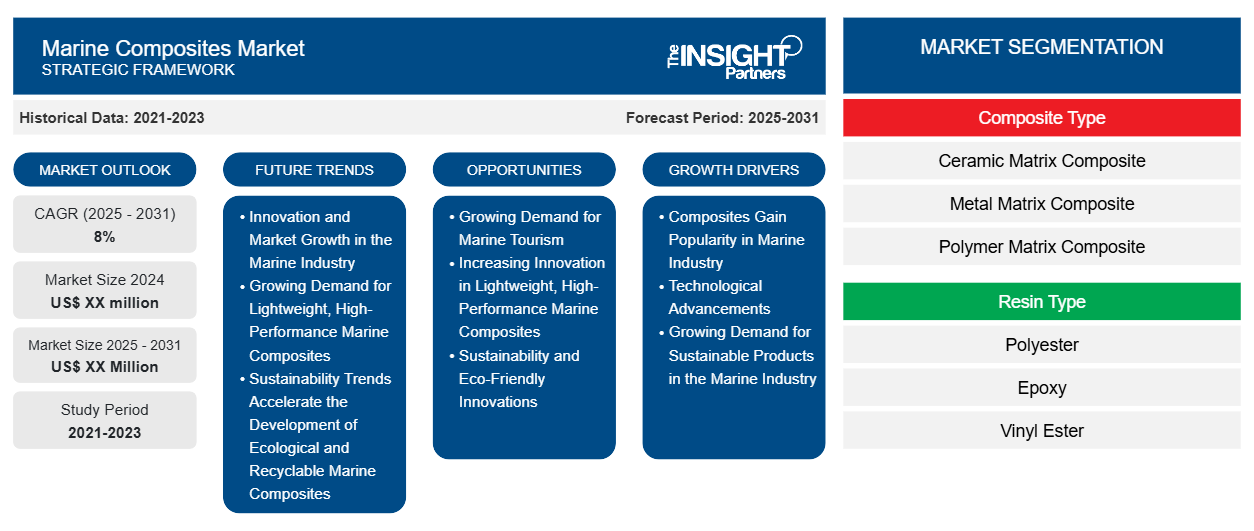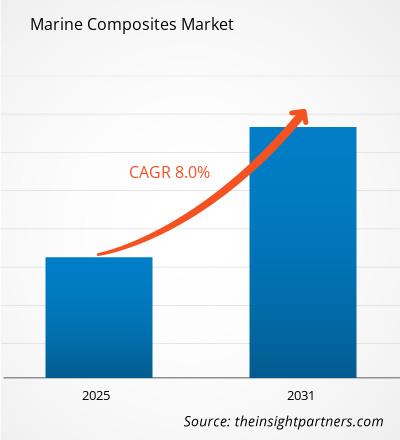海洋複合材料市場は、 2024年から2031年にかけて8%のCAGRを記録し、市場規模は2024年のXX百万米ドルから2031年にはXX百万米ドルに拡大すると予想されています。
レポートは、複合材タイプ(セラミックマトリックス複合材(CMC)、金属マトリックス複合材(MMC)、ポリマーマトリックス複合材(PMC)、その他)別にセグメント化されています。また、樹脂タイプ(ポリエステル、エポキシ、ビニルエステル、熱可塑性樹脂、その他)と船舶タイプ(ヨット、クルーズ船、パワーボート、その他)に基づいてセグメント化されています。レポートの範囲は、北米、ヨーロッパ、アジア太平洋、中東およびアフリカ、南米および中米の5つの地域と、各地域の主要国をカバーしています。グローバル分析は、地域レベルと主要国でさらに細分化されています。レポートは、上記の分析とセグメントに対してUSDでの値を提供します。
報告書の目的
The Insight Partners のレポート「海洋複合材料市場」は、現在の状況と将来の成長、主な推進要因、課題、機会を説明することを目的としています。これにより、次のようなさまざまなビジネス関係者に洞察が提供されます。
- テクノロジープロバイダー/メーカー: 進化する市場の動向を理解し、潜在的な成長機会を把握することで、情報に基づいた戦略的意思決定が可能になります。
- 投資家: 市場の成長率、市場の財務予測、バリュー チェーン全体に存在する機会に関する包括的な傾向分析を実施します。
- 規制機関: 市場の濫用を最小限に抑え、投資家の信用と信頼を維持し、市場の完全性と安定性を維持することを目的として、市場における政策と警察活動を規制します。
海洋複合材料市場のセグメンテーション
複合タイプ
- セラミックマトリックス複合材
- 金属マトリックス複合材
- ポリマーマトリックス複合材
樹脂タイプ
- ポリエステル
- エポキシ
- ビニルエステル
- 熱可塑性
船種
- 帆船
- クルーズ船
- パワーボート
地理
- 北米
- ヨーロッパ
- アジア太平洋
- 南米と中央アメリカ
- 中東およびアフリカ
要件に合わせてレポートをカスタマイズする
このレポートの一部、国レベルの分析、Excelデータパックなど、あらゆるレポートを無料でカスタマイズできます。また、スタートアップや大学向けのお得なオファーや割引もご利用いただけます。
- このレポートの主要な市場動向を入手してください。この無料サンプルには、市場動向から見積もりや予測に至るまでのデータ分析が含まれます。
海洋複合材料市場の成長要因
- 複合材は海洋産業で人気を博しています。海洋環境では、より厳しい材料が求められます。これらの環境では、材料は簡単に腐食したり劣化したりしません。複合材は海水や腐食性成分によく耐えるため、複合材を使用した造船が好まれます。この耐久性により、船舶の寿命が延びるだけでなく、メンテナンス費用も削減され、市場拡大につながります。
- 技術の進歩: 複合材の高度な製造技術は、新しい用途の導入と性能特性の向上に役立っています。樹脂配合の改善と繊維強化の強化により、海洋用途向けのより効率的で持続可能な複合材の製造が可能になり、変化する海洋産業の需要を満たすには技術の進歩が最も重要です。
- 海洋産業における持続可能な製品に対する需要の高まり: 海洋産業は現在、軽量で高強度の素材へと進歩しており、これにより機能性が向上し、船舶の燃料消費量が削減されます。複合材は全体の重量を軽減するため、船舶の航行速度が速くなり、燃料消費量も少なくなります。メーカーが業界標準の変化に合わせて革新的な素材にアップグレードしているため、性能の向上と環境の持続可能性に対する需要が海洋複合材市場を牽引しています。
海洋複合材料市場の将来動向
- 海洋産業におけるイノベーションと市場の成長: 炭素繊維複合材の並外れた強度と軽量特性により、海洋分野での炭素繊維複合材の需要は急速に高まっています。このような性能上の利点と軽量化により、メーカーは炭素繊維を高級ヨットからより大規模な商業用途へと移行させ、イノベーションを推進して市場シェアを拡大しています。
- 軽量で高性能な海洋複合材の需要の高まり: パワーボート市場は予測期間中に高い割合で成長しています。これは、スピードと燃料効率を向上させる軽量で高性能な材料の需要が高まり、ボート製造業者が設計に海洋複合材を使用するケースが増えているためです。
- 持続可能性のトレンドが環境に優しくリサイクル可能な海洋複合材の開発を加速: 持続可能性は海洋部門の新たな関心事にもなっており、「環境に優しい複合材」へのトレンドがますます高まっています。そのため、悪影響を軽減するために新しい「グリーン」素材を開発するための努力が高まっています。さらに、より環境に優しい側面のために、さまざまな形態のリサイクル可能な複合材技術も活用されています。これは、世界中の事業分野にわたるより広範な「持続可能性イニシアチブ」とも密接に連携して進んでいます。
海洋複合材料の市場機会
- 海洋観光の需要の高まり: 海洋観光の需要の高まりは、海洋複合材市場に大きな可能性をもたらします。水上でのアクティビティへの関心が高まるにつれ、人々はクルーズ船やその他のレジャー船を必要としています。これにより、メーカーは、特に観光分野に適した高度な複合材を革新し、製造する強い動機が生まれます。
- 軽量で高性能な船舶用複合材の革新の増加: 軽量で高性能な船舶に対する消費者の好みが、パワーボート分野の需要を牽引しています。この成長により、メーカーは速度と燃料効率、全体的な性能を向上させる複合材を開発する機会を得て、商業的に魅力的な市場に到達できます。
- 持続可能性と環境に優しいイノベーション: 持続可能性に対する意識は世界的に高まっており、より環境に優しい海洋複合材の開発の機会がさらに増えています。バイオベースの樹脂やリサイクル可能な材料からのイノベーションは、環境を気にする消費者を引き付け、規制の要求を満たし、環境フットプリントの削減にこれまで以上に重点が置かれる市場で企業を前進させます。
海洋複合材料市場の地域別洞察
予測期間を通じて海洋複合材料市場に影響を与える地域的な傾向と要因は、Insight Partners のアナリストによって徹底的に説明されています。このセクションでは、北米、ヨーロッパ、アジア太平洋、中東、アフリカ、南米、中米にわたる海洋複合材料市場のセグメントと地理についても説明します。

- 海洋複合材料市場の地域別データを入手
海洋複合材料市場レポートの範囲
| レポート属性 | 詳細 |
|---|---|
| 2024年の市場規模 | XX百万米ドル |
| 2031年までの市場規模 | XX百万米ドル |
| 世界のCAGR(2024年 - 2031年) | 8% |
| 履歴データ | 2021-2023 |
| 予測期間 | 2025-2031 |
| 対象セグメント | 複合タイプ別
|
| 対象地域と国 | 北米
|
| 市場リーダーと主要企業プロフィール |
|
海洋複合材料市場のプレーヤー密度:ビジネスダイナミクスへの影響を理解する
海洋複合材料市場は、消費者の嗜好の変化、技術の進歩、製品の利点に対する認識の高まりなどの要因により、エンドユーザーの需要が高まり、急速に成長しています。需要が高まるにつれて、企業は提供を拡大し、消費者のニーズを満たすために革新し、新たなトレンドを活用し、市場の成長をさらに促進しています。
市場プレーヤー密度とは、特定の市場または業界内で活動している企業または会社の分布を指します。これは、特定の市場スペースに、その規模または総市場価値と比較して、どれだけの競合相手 (市場プレーヤー) が存在するかを示します。
海洋複合材料市場で事業を展開している主要企業は次のとおりです。
- 三菱レイヨン株式会社
- ヘクセル株式会社
- オーウェンス・コーニング
- サイテック ソルベイ グループ
- EI デュポン ド ヌムール アンド カンパニー
免責事項:上記の企業は、特定の順序でランク付けされていません。

- 海洋複合材料市場のトップキープレーヤーの概要を入手
主なセールスポイント
- 包括的なカバレッジ: レポートでは、海洋複合材料市場の製品、サービス、タイプ、エンドユーザーの分析を包括的にカバーし、全体的な展望を提供します。
- 専門家による分析: レポートは、業界の専門家とアナリストの深い理解に基づいてまとめられています。
- 最新情報: このレポートは、最新の情報とデータの傾向を網羅しているため、ビジネスの関連性を保証します。
- カスタマイズ オプション: このレポートは、特定のクライアント要件に対応し、ビジネス戦略に適切に適合するようにカスタマイズできます。
したがって、海洋複合材料市場に関する調査レポートは、業界のシナリオと成長の見通しを解読し理解する道の先導役となることができます。いくつかの正当な懸念があるかもしれませんが、このレポートの全体的な利点は欠点を上回る傾向があります。
- 過去2年間の分析、基準年、CAGRによる予測(7年間)
- PEST分析とSWOT分析
- 市場規模価値/数量 - 世界、地域、国
- 業界と競争環境
- Excel データセット



Report Coverage
Revenue forecast, Company Analysis, Industry landscape, Growth factors, and Trends

Segment Covered
This text is related
to segments covered.

Regional Scope
North America, Europe, Asia Pacific, Middle East & Africa, South & Central America

Country Scope
This text is related
to country scope.
よくある質問
Based on geography, Asia Pacific is expected to register the fastest CAGR from 2023 to 2031.
The report can be delivered in PDF/Word format, we can also share excel data sheet based on request.
Advancements in sustainable materials is one of the key opportunities for the market growth.
Mitsubishi Rayon Co Ltd, Hexcel Corporation, Owens Corning, Solvay, Dupont, Gurit, SGL Carbon, Airborne, Teijin Carbon Europe GmbH, and Zoltek Corporation are among the leading players operating in the marine composites market.
Growing demand for lightweight and high-strength materials is driving the market growth
The Marine Composites Market is estimated to witness a CAGR of 8% from 2023 to 2031
Trends and growth analysis reports related to Chemicals and Materials : READ MORE..
The List of Companies
- Mitsubishi Rayon Co. Ltd.
- Hexcel Corporation
- Owens Corning
- Cytec Solvay Group
- E. I. Du Pont De Nemours and Company
- Gurit Holding
- SGL Group
- Airborne
- Teijin Limited
The Insight Partners performs research in 4 major stages: Data Collection & Secondary Research, Primary Research, Data Analysis and Data Triangulation & Final Review.
- Data Collection and Secondary Research:
As a market research and consulting firm operating from a decade, we have published and advised several client across the globe. First step for any study will start with an assessment of currently available data and insights from existing reports. Further, historical and current market information is collected from Investor Presentations, Annual Reports, SEC Filings, etc., and other information related to company’s performance and market positioning are gathered from Paid Databases (Factiva, Hoovers, and Reuters) and various other publications available in public domain.
Several associations trade associates, technical forums, institutes, societies and organization are accessed to gain technical as well as market related insights through their publications such as research papers, blogs and press releases related to the studies are referred to get cues about the market. Further, white papers, journals, magazines, and other news articles published in last 3 years are scrutinized and analyzed to understand the current market trends.
- Primary Research:
The primarily interview analysis comprise of data obtained from industry participants interview and answers to survey questions gathered by in-house primary team.
For primary research, interviews are conducted with industry experts/CEOs/Marketing Managers/VPs/Subject Matter Experts from both demand and supply side to get a 360-degree view of the market. The primary team conducts several interviews based on the complexity of the markets to understand the various market trends and dynamics which makes research more credible and precise.
A typical research interview fulfils the following functions:
- Provides first-hand information on the market size, market trends, growth trends, competitive landscape, and outlook
- Validates and strengthens in-house secondary research findings
- Develops the analysis team’s expertise and market understanding
Primary research involves email interactions and telephone interviews for each market, category, segment, and sub-segment across geographies. The participants who typically take part in such a process include, but are not limited to:
- Industry participants: VPs, business development managers, market intelligence managers and national sales managers
- Outside experts: Valuation experts, research analysts and key opinion leaders specializing in the electronics and semiconductor industry.
Below is the breakup of our primary respondents by company, designation, and region:

Once we receive the confirmation from primary research sources or primary respondents, we finalize the base year market estimation and forecast the data as per the macroeconomic and microeconomic factors assessed during data collection.
- Data Analysis:
Once data is validated through both secondary as well as primary respondents, we finalize the market estimations by hypothesis formulation and factor analysis at regional and country level.
- Macro-Economic Factor Analysis:
We analyse macroeconomic indicators such the gross domestic product (GDP), increase in the demand for goods and services across industries, technological advancement, regional economic growth, governmental policies, the influence of COVID-19, PEST analysis, and other aspects. This analysis aids in setting benchmarks for various nations/regions and approximating market splits. Additionally, the general trend of the aforementioned components aid in determining the market's development possibilities.
- Country Level Data:
Various factors that are especially aligned to the country are taken into account to determine the market size for a certain area and country, including the presence of vendors, such as headquarters and offices, the country's GDP, demand patterns, and industry growth. To comprehend the market dynamics for the nation, a number of growth variables, inhibitors, application areas, and current market trends are researched. The aforementioned elements aid in determining the country's overall market's growth potential.
- Company Profile:
The “Table of Contents” is formulated by listing and analyzing more than 25 - 30 companies operating in the market ecosystem across geographies. However, we profile only 10 companies as a standard practice in our syndicate reports. These 10 companies comprise leading, emerging, and regional players. Nonetheless, our analysis is not restricted to the 10 listed companies, we also analyze other companies present in the market to develop a holistic view and understand the prevailing trends. The “Company Profiles” section in the report covers key facts, business description, products & services, financial information, SWOT analysis, and key developments. The financial information presented is extracted from the annual reports and official documents of the publicly listed companies. Upon collecting the information for the sections of respective companies, we verify them via various primary sources and then compile the data in respective company profiles. The company level information helps us in deriving the base number as well as in forecasting the market size.
- Developing Base Number:
Aggregation of sales statistics (2020-2022) and macro-economic factor, and other secondary and primary research insights are utilized to arrive at base number and related market shares for 2022. The data gaps are identified in this step and relevant market data is analyzed, collected from paid primary interviews or databases. On finalizing the base year market size, forecasts are developed on the basis of macro-economic, industry and market growth factors and company level analysis.
- Data Triangulation and Final Review:
The market findings and base year market size calculations are validated from supply as well as demand side. Demand side validations are based on macro-economic factor analysis and benchmarks for respective regions and countries. In case of supply side validations, revenues of major companies are estimated (in case not available) based on industry benchmark, approximate number of employees, product portfolio, and primary interviews revenues are gathered. Further revenue from target product/service segment is assessed to avoid overshooting of market statistics. In case of heavy deviations between supply and demand side values, all thes steps are repeated to achieve synchronization.
We follow an iterative model, wherein we share our research findings with Subject Matter Experts (SME’s) and Key Opinion Leaders (KOLs) until consensus view of the market is not formulated – this model negates any drastic deviation in the opinions of experts. Only validated and universally acceptable research findings are quoted in our reports.
We have important check points that we use to validate our research findings – which we call – data triangulation, where we validate the information, we generate from secondary sources with primary interviews and then we re-validate with our internal data bases and Subject matter experts. This comprehensive model enables us to deliver high quality, reliable data in shortest possible time.


 このレポートの無料サンプルを入手する
このレポートの無料サンプルを入手する